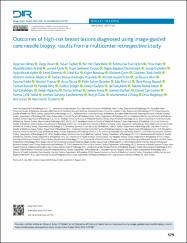| dc.contributor.author | Oktay, Ayşenur | |
| dc.contributor.author | Aslan, Özge | |
| dc.contributor.author | Taşkın, Füsun | |
| dc.contributor.author | Dinç, Funda | |
| dc.date.accessioned | 2023-09-08T11:16:05Z | |
| dc.date.available | 2023-09-08T11:16:05Z | |
| dc.date.issued | 2023 | en_US |
| dc.identifier.citation | Oktay A, Aslan Ö, Taşkın F, et al. Outcomes of high-risk breast lesions diagnosed using image-guided core needle biopsy: results
from a multicenter retrospective study. Diagn Interv Radiol. 2023;29(4):579-587. | en_US |
| dc.identifier.issn | 1305-3612 | |
| dc.identifier.uri | https://hdl.handle.net/20.500.12809/10949 | |
| dc.description.abstract | PURPOSE The clinical management of high-risk lesions using image-guided biopsy is challenging. This study aimed to evaluate the rates at which such lesions were upgraded to malignancy and identify possible predictive factors for upgrading high-risk lesions. METHODS This retrospective multicenter analysis included 1.343 patients diagnosed with high-risk lesions using an image-guided core needle or vacuum-assisted biopsy (VAB). Only patients managed using an excisional biopsy or with at least one year of documented radiological follow-up were included. For each, the Breast Imaging Reporting and Data System (BI-RADS) category, number of samples, needle thickness, and lesion size were correlated with malignancy upgrade rates in different histologic subtypes. Pearson's chi-squared test, the Fisher-Freeman-Halton test, and Fisher's exact test were used for the sta-tistical analyses. RESULTS The overall upgrade rate was 20.6%, with the highest rates in the subtypes of intraductal papilloma (IP) with atypia (44.7%; 55/123), followed by atypical ductal hyperplasia (ADH) (38.4%; 144/375), lobular neoplasia (LN) (12.7%; 7/55), papilloma without atypia (9.4%; 58/611), flat epithelial atypia (FEA) (8.7%; 10/114), and radial scars (RSs) (4.6%; 3/65). There was a significant relationship between the upgrade rate and BI-RADS category, number of samples, and lesion size Lesion size was the most predictive factor for an upgrade in all subtypes.CONCLUSION ADH and atypical IP showed considerable upgrade rates to malignancy, requiring surgical excision. The LN, IP without atypia, pure FEA, and RS subtypes showed lower malignancy rates when the BI-RADS category was lower and in smaller lesions that had been adequately sampled using VAB. After being discussed in a multidisciplinary meeting, these cases could be managed with follow-up instead of excision | en_US |
| dc.item-language.iso | eng | en_US |
| dc.publisher | GALENOS PUBL HOUSE | en_US |
| dc.relation.isversionof | 10.4274/dir.2022.221790 | en_US |
| dc.item-rights | info:eu-repo/semantics/openAccess | en_US |
| dc.subject | Core needle biopsy | en_US |
| dc.subject | B3 lesions | en_US |
| dc.subject | Breast cancer | en_US |
| dc.subject | İmage guided breast biopsy | en_US |
| dc.title | Outcomes of high-risk breast lesions diagnosed using image-guided core needle biopsy: results from a multicenter retrospective study | en_US |
| dc.item-type | article | en_US |
| dc.contributor.department | MÜ, Tıp Fakültesi, Dahili Tıp Bilimleri Bölümü | en_US |
| dc.contributor.authorID | 0000-0002-3979-4413 | en_US |
| dc.contributor.institutionauthor | Dinç, Funda | |
| dc.identifier.volume | 29 | en_US |
| dc.identifier.issue | 4 | en_US |
| dc.identifier.startpage | 579 | en_US |
| dc.identifier.endpage | 587 | en_US |
| dc.relation.journal | DIAGNOSTIC AND INTERVENTIONAL RADIOLOGY | en_US |
| dc.relation.publicationcategory | Makale - Uluslararası Hakemli Dergi - Kurum Öğretim Elemanı | en_US |


















